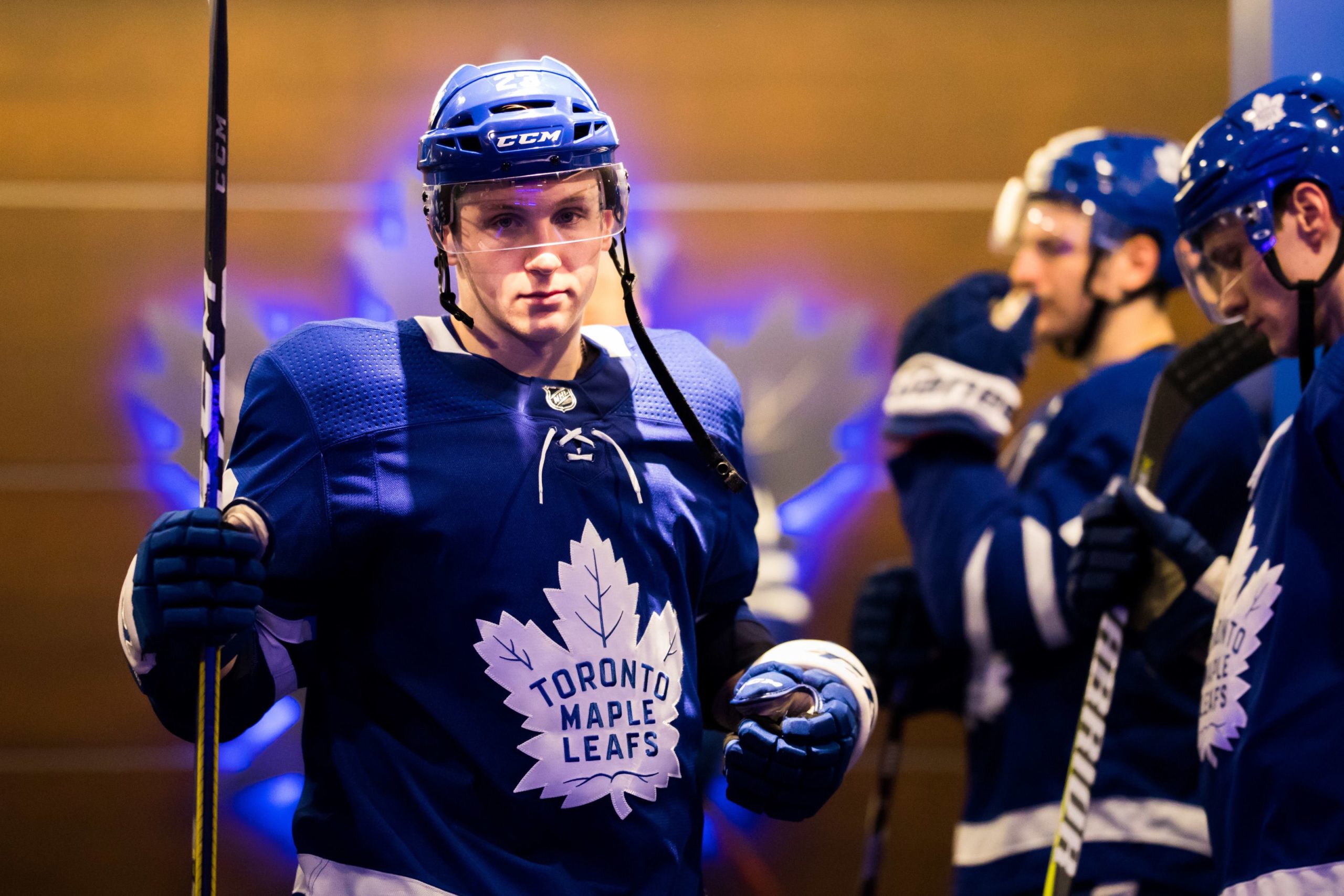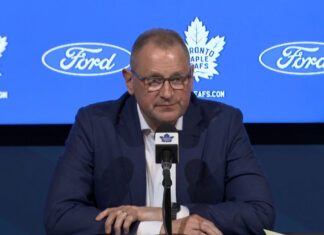In the final six-game stint before the world turned upside down and after Jake Muzzin broke his hand in late February, Travis Dermott was thrust into tough minutes on the Toronto Maple Leafs’ top pair alongside former Toronto Marlies running mate Justin Holl.
Those assignments included head-to-head matchups against the top lines of Tampa Bay, Florida, and Vancouver. The 23-year-old Dermott not only passed the test but scored well on it, playing probably his best hockey as an NHLer.
In the Leafs’ final game before the 2019-20 regular season shut down for good, while they did carry the majority of the shot attempts, Tampa Bay’s Kucherov, Point and Palat line split the shots on goal and were held scoreless at 5v5 in 10 minutes head-to-head with Dermott and Holl.
The week previous, the pairing matched up against Pettersson, Miller, and Toffoli with nearly identical results — while the pair was out-possessed, the shots were even and the Canucks’ big line was held scoreless at even strength in 12+ minutes head-to-head.
Dermott – Holl’s best night came against Florida in the game after Muzzin’s injury in Tampa Bay — 11-3 in shot attempts, 6-2 in shots, and 1-0 in goals at 5v5 up against the Barkov, Huberdeau and Dadonov line.
“They did an excellent job,” said Sheldon Keefe after the team’s 5-3 win in Sunrise. “Matched up against the Barkov line, it is the entire group doing a job against them, but that line ends up off the scoresheet and -2 on the night.”
Over 93 five-on-five minutes together spanning the six games, the pairing managed to tread water in both shots and goals share (1 goal for, 1 against) while out-chancing the opposition by a fair margin — 43-32.
The skill sets of Holl and Dermott appeared to complement each other well — both are mobile skaters over all ranges, excel at holding the defensive zone blue and gapping up tightly against the rush, and can either skate the puck out of danger or reliably execute an outlet pass. In that six-game stint, Dermott also showed more judicious decision-making and generally avoided over-committing in his reads up ice, which had burned him against high-end NHL competition in the past and contributed to trust issues with former coach Mike Babcock.
If we ignore the five-month time-lapse, one way to look at it is that Dermott and Holl were excelling together in a big role just four games ago. With today’s news on Jake Muzzin’s status — he is going to be okay (thankfully), but isn’t expected back before the best-of-five series is decided against Columbus — the Leafs are hoping the two can essentially pick up where they left off prior to the pause.
Sheldon Keefe: “[Travis Dermott] can handle it when called upon”
Muzzin’s absence leaves a major hole to fill — the veteran defenseman struggled a little bit in Game 1 alongside Holl in terms of getting the puck moving north and exiting the zone efficiently, but Game 2 largely featured the physical, defensively-stiff, capable puck mover and leader the Leafs committed $5.63 million a year to for the next four seasons back in March.
One of the silver linings to injuries in the regular season, though, is that it better prepares a team for the inevitable adversity a playoff run brings, be it different line options for when the offense dries up, or the loss of key personnel on the blue line.
The Leafs have plenty of experience with the latter this past season. At different times, they went without Muzzin (17 games), Morgan Rielly (23 games), and Cody Ceci (14 games) — including a period where all three were sidelined at once. At one point in early March, the team was icing a blue line with a combined cap hit of $6.63 million — there were four forwards on the team with larger individual cap hits on their respective contracts than the entire defense corps.
In addition to the coaching staff witnessing a sample of Dermott on the top pair role next to Holl, Martin Marincin spent some shifts next to Tyson Barrie before the suspension of the season. Understandably, it’s not a pairing Leafs fans are resting easy about going into Game 3 — and Keefe went away from it after the dismal California road trip in early March — but in a handful of games together before March 12, the pairing did at least break even in goals share (60% GF in 44 even-strength minutes), and Marincin’s ability on the penalty kill has never been in question.
It remains to be seen how this pairing will cope with the Columbus forecheck. Tyson Barrie has become only a sheltered bottom-pairing and PP option at this stage for the Leafs, and he has all too easily allowed forwards in behind him or been bullied off of pucks for most of the season. Marincin will need to find his confidence quickly — it has always been his cross to bear — while he’s tasked with jumping into playoff action midstream after so much time off.
That said, if there is a second reason — beyond the play of Dermott-Holl before the pause — to be optimistic about the Leafs’ chances despite the loss of Muzzin for the rest of the series, it’s the encouraging level of commitment away from the puck we’ve seen from the Leafs’ best players through two games.
Matthews’ breakthrough goal — the first of the series after 96 minutes of shutout hockey from the Blue Jackets and goaltender Joonas Korpisalo — came at the end of a long shift in which he twice tracked back hard through neutral ice to break up plays and recover pucks. One goal isn’t a true reflection of his offensive opportunities and overall play so far this series; he’s been the dominant force down the middle the Leafs need him to be.
While he’s yet to make an imprint on the series offensively, to my eye, Nylander has been engaged in much the same way. John Tavares — fighting it in Game 1, and offensive struggles for the first five periods of the series aside — bounced back in a big way with a dominant showing over 200 feet in Game 2.
On line three, Kerfoot and Kapanen have, for the most part, been consistent in their efforts to pressure the puck both on the forecheck and when tracking back defensively, even if the offense hasn’t been there.
Encouragingly, while this Blue Jackets team clearly lacks offensive game-breakers, the Leafs have given up just one goal through 120 minutes (excluding the empty netter), and it came on a wobbly wrister from the wall on a solo rush by Cam Atkinson.
Both Kyle Dubas and Sheldon Keefe have shared the view in recent weeks that the Leafs need to mature in their defensive mindset this summer — that it’s not so much a personnel or roster-balance issue as it is a matter of embracing the commitment to wanting to be good defensively. In order to learn how to win, President Brendan Shanahan has often argued that a team needs to develop a certain honed resilience through the accumulation of adversity-inflicted scar tissue.
“I had a player ask me at the start of year what I think about or worry about sometimes and where I see our development,” said Shanahan last Spring. “I said, ‘I think we are certainly in the window where we can win. I sometimes wonder whether or not we’ve got enough scar tissue. I sometimes wonder whether we’ve got enough experience.’ But you can’t get it without doing it. You can’t get scar tissue without scraping your knee sometimes.”
A Game 1 shutout loss followed by a bounce-back win — at the cost of losing Jake Muzzin for the rest of the series — is an unfortunate but fitting way to start the Return to Play playoff after a 2019-20 regular season chocked full of trials and tribulations for this Leafs team. Now we’ll find out if all of it prepared them to step up and persevere in the moments when it matters most.

































